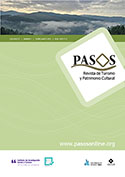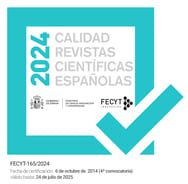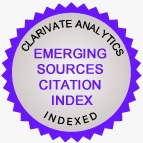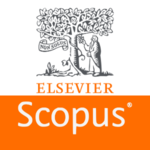De sem-vergonha a sem-vergonha: um estudo de caso entre cliente-hóspede em apartamentos turísticos
DOI:
https://doi.org/10.25145/j.pasos.2025.23.007Palavras-chave:
vergüenza, sinvergüenza, hostelería, beneficios, valores éticosResumo
As relações entre os membros de um grupo social/cultural são objeto de estudo há décadas, sendo a vergonha um dos principais sentimentos gerados pelo não cumprimento de normas previamente estabelecidas, que variam de sociedade e geração para geração. Com o afrouxamento dos valores éticos, a cultura da reclamação e a troca de opiniões, a vergonha parece ter-se diluído em diversas áreas, principalmente na hotelaria, trazendo benefícios para o cliente e sentimentos negativos para o empregador. O objetivo do estudo foi analisar a estreita relação entre a não vergonha e a geração do termo canalha. O instrumento de pesquisa utilizado para a coleta de dados foi um questionário baseado na escala Likert com 5 possibilidades de resposta em relação às hipóteses deste estudo e uma pergunta de opinião lançada por um grupo de WhatsApp. Utilizando o método baseado na modelação de equações estruturais (SEM-PLS), foi recolhido um total de 116 respostas de prestadores de serviços de hotelaria. Os resultados revelaram que não ter vergonha beneficia os hóspedes quando se trata de obter serviços extra, no entanto, gera uma palavra negativa entre os hoteleiros.
Downloads
##plugins.generic.pfl.publicationFactsTitle##
##plugins.generic.pfl.reviewerProfiles## Indisp.
##plugins.generic.pfl.authorStatements##
##plugins.generic.pfl.indexedIn##
-
##plugins.generic.pfl.indexedList##
- ##plugins.generic.pfl.academicSociety##
- PASOS. Revista de Turismo y Patrimonio Cultural
- ##plugins.generic.pfl.publisher##
- Instituto Universitario de Investigación Social y Turismo. Universidad de La Laguna (España) - Instituto Universitario da Maia ISMAI (Portugal)
Referências
Ahmed, S. (2015). La vergüenza ante los demás. En S. Ahmed, La política cultural de las emociones. México. Unam. https://www.puees.unam.mx/curso2021/materiales/Sesion14/Ahmed2015_LaPoliticaCulturalDeLasEmociones.pdf
Ali, F. (2016). Hotel website quality, perceived flow, customer satisfaction and purchase intention. Journal of Hospitality and Tourism Technology, 7(2), 213–228. https://doi.org/10.1108/JHTT-02-2016-0010
Baloglu, S.,& McCleary, K.W. (1999). US International pleasure travelers´ images of four Mediterranean destinations: A comparison of visitors and non-visitors. Journal of Travel Research, 38(2), 144–152. https://doi.org/10.1177/004728759903800207
Baltes, P.B., Linderberger, U.,& Staudinger, U.M. (1999). Lifespan Psychology:
Theory and application to intellectual functioning. Annual Rev Psychology,
, 471–507. https://doi.org/10.1146/annurev.psych.50.1.471
Bastiaansen, M., Lub, X., Mitas, O., Jung, T., Ascenção, M.P., Han, D., Moilanen, T., Smit, B.,& Strijbosch, W. (2019). Emotions as core building blocks of an experience. International Journal of Contemporary Hospitality Management, 31(2), 651–668. https://doi.org/10.1108/IJCHM-11-2017-0761
Bentler, P.M.,& Bonnet, D.G. (1980). Significance tests and goodness-of-fit in the analysis of covariance structures. Psychological Bulletin, 88, 588–606. https://doi.org/10.1037/0033-2909.88.3.588
Bigné, E., Chumpitaz, R., Andreu, L.,& Swaen, V. (2005). Percepción de la responsabilidad social corporativa: un análisis cross-cultural. UCJC Business and Society Review 1(5). https://journals.ucjc.edu/ubr/article/view/516
Brown, B. (2007). I Thought It Was Just Me (but it isn't): Making the Journey from "What Will People Think?" to "I Am Enough". Avery.
Camargo, L.O.L. (2015). Os interstícios da hospitalidade. Revista Hospitalidade, 12(especial), 42–69. http://www.spell.org.br/documentos/ver/35195/os-intersticios-da-hospitalidade-/i/pt-br
Camisón, C., Navarro, M.,& López, A. (2009). Sistemas de gestión de la calidad y desempeño: importancia de las prácticas de gestión del conocimiento y de I+D. Revista Europea de Dirección y Economía de la Empresa, 18(1), 123–134. http://hdl.handle.net/10234/33356
Carmines, E.G.,& Zeller, R.A. (1979). Reliability and validity assessment (Vol. 17). California: SAGE Publications.
Chen, Y.,& Tussyadiah, I. (2021). Service failure in peer-to-peer accommodation. Annals of Tourism Research, Elsevier, 88(C). https://doi.org/10.1016/j.annals.2021.103156
Chin, W. W. (1998). The partial least squares approach to structural equation modeling. Modern Methods for Business Research, 295(2), pp. 295–336. https://psycnet.apa.org/record/1998-07269-010
Chung, H. (2012). Measuring Flexicurity: Precautionary Notes, a New Framework, and an Empirical Example. Social Indicators Research, 106(1), 153–171. https://doi.org/10.1007/s11205-011-9800-2
Creswell, J.W.,& Creswell, J.D. (2018) Research Design: Qualitative, Quantitative, and Mixed Methods Approaches. Sage, Los Angeles.
Crompton, J.L. (1979). Motivations for pleasure vacation. Annals of Tourism Research, 6(4), 408–424.
https://doi.org/10.1016/0160-7383(79)90004-5
Cruz, I.,& Galán, J. (2019). Determinantes del comportamiento del consumidor en México. Acta Universitaria, 29(1), 1–17. https://doi.org/10.15174au.2019.2076
Dahnil, M.I, Kamarul, M., Langgat, J.,& Fabeil, N. (2014). Factors influencing SMEs adoption of social media marketing. Procedia - Social and Behavioral Sciences, 148, 119–126.
https://doi.org/10.1016/j.sbspro.2014.07.025
Del Bosque, I.R.,& Martin, H.S. (2008). Tourist satisfaction a cognitive-affective model. Annals of Tourism Research, 35(2), 551–573.http://dx.doi.org/10.1016/j.annals.2008.02.006
Dunlap, R.E., Van Lieres, K.D., Mertig, A.G.,& Jones, R.E. (2000). Measuring endorsement of the new ecological Paradigm: a revisited neP. Journal of Social Issues, 56(3), 425–442. https://doi.org/10.1111/0022-4537.00176
Flores, C. (2019). Gestionar óptimamente las reclamaciones para alcanzar la satisfacción del cliente. Aenor. Revista de la evaluación de la conformidad, (344), 23-27.https://revista.aenor.com/downloads/re-
vistas/344.pdf?output=52e58a93ecacb373f202592e64b1822e
Fornell, C.G., & Bookstein, F. L. (1982). Two structural equation models: LISREL and PLS
applied to consumer exit-voice theory. Journal of Marketing Research, 19(4), 440–452.
Gerhards, J. (1986). Georg Simmel’s contribution to a theory of emotions. Social Science Information 25(4), 901–924. https://doi.org/10.1177/053901886025004007
Goss, K., Gilbert, P., & Allan, S. (Eds.). (1994). Shame: Interpersonal Behavior, Psychopathology, and Culture. Oxford University Press.
Hair, J. F., Howard, M. C., & Nitzl, C. (2020). Assessing measurement model quality in PLS-SEM
using confirmatory composite analysis. Journal of Business Research, 109, 101–110. https://doi.org/10.1016/j.jbusres.2019.11.069
Henseler, J. (2021). Composite-based structural equation modeling: Analyzing latent and emergent
variables. New York: Guilford Press.
Hsiao, K.L., Huang, T.C., Chen, M.Y.,& Chiang, N.T. (2018). Understanding the behavioral intention to play Austronesian learning games: from the perspectives of learning outcome, service quality, and hedonic value. Interactive Learning Environments, 26(3), 372–385. https://discovery.dundee.ac.uk/ws/portalfiles/portal/51952060/scoping_review.pdf
Kincl, T.,& Štrach, P. (2018). Gender differences in online customer satisfaction: the asymmetric and nonlinear effect. Services Marketing Quarterly,39(3), 157–174.https://doi.org/10.1080/15332969.2018.1471954
Nathanson, D. L. (1987). The many faces of shame. Guilford Press.
Nepstad, S. (2004). Convictions of the Soul. New York: Oxford Univ. Press.
Nunberg, G. (2018). The social life of slurs. En D.Fogal, D.W. Harris y M. Moss, (Eds.),New work on speech acts (pp. 237–295). Oxford University Press. https://doi.org/10.1093/oso/9780198738831.003.0010
Orlando, E.,& Saab, A. (2019). Términos peyorativos de grupo, estereotipos y actos de habla. Crítica. Revista Hispanoamericana de Filosofía, 51(153). https://doi.org/10.22201/iifs.18704905e.2019.1147
Prahalad, C.K.,& Ramaswamy, V. (2004). Co-Creating Unique Value With Customers. Strategy & Leadership. 32, 4–9. https://doi.org/10.1108/10878570410699249.
Quan, S.,& Wang, N. (2004). Towards a structural model of the tourist experience: An illustration from food experiences in tourism. Tourism Management, 25(3), 297–305. https://doi.org/10.1016/S0261-5177(03)00130-4.
Real academia española (s.f.). Sinvergüenza. En el Diccionario Rae. https://dle.rae.es/sinverg%C3%BCenza
Ryu, K., Han, H.,& Jang, S. (2010). Relationships among hedonic and utilitarian values, satisfaction and behavioral intentions in the fast-casual restaurant industry. International Journal of Contemporary Hospitality Management, 22(3), 416–432. https://doi.org/10.1108/09596111011035981
Sabido Ramos, O. (2019). El análisis sociológico de la vergüenza en Georg Simmel. Una propuesta para pensar el carácter performativo y relacional de las emociones”. Digithum 23(1), 1–15. https://doi.org/10.7238/d.v0i23.3148
Sánchez González, M.G. (2021). Tesis doctoral "La música como vehículo de formación ética en los jóvenes". Universidad de Extremadura. http://hdl.handle.net/10662/12659
Sans, A.A.,& Domínguez Quaglieri, A. (2016). Unravelling Airbnb: Urban perspectives from Barcelona. Reinventing the Local in Tourism: Producing, Consuming and Negotiating Place. Channel View Publications, 209–228. https://doi.org/10.21832/9781845415709-015
Sarstedt, M., Hair, J.F., Ringle, C.M., Thiele, K.O.,& Gudergan, S.P. (2016). Estimation issues
with PLS and CBSEM: Where the bias lies! Journal of Business Research, 69(10), 3998–4010. https://doi.org/10.1016/j.jbusres.2016.06.007
Scheff, T. (1990). Shame and conformity: The deference-emotion system: En Microsociology. Discourse, Emotion, and Social Structure, 71-95. Chicago: The University of Chicago Press.
Schwartz, S.H.,& Howard, J.A. (1981). A normative decision-making model of altruism. In J.P. Rushton & R.M. Sorrentino, Eds., Altruism and Helping Behavior: Social, Personality, and Developmental Perspectives, 189–211. Lawrence Erlbaum.
Seebach, S. (2017). Love and Society: Special Social Forms and the Master Emotion. Nueva York/Londres: Routledge.
Sepúlveda, C., González, J.,& Gallego, J. (2019). Dinámica del bienestar social en Bogotá y su región. Universidad del Rosario. https://doi.org/10.12804/cc9789587843620
Sheldon, K., Turban, D., Brown, K., Barrick, M.,& Judge, T. (2003). Applying self-determination theory to organizational research. Research in Personnel and Human Resources Management, 22, 357–393. https://doi.org/10.1016/S0742-7301(03)22008-9
Simmel, G., Vernik, E.,& Ackermann Pilári, Al. (2018). Cuestiones fundamentales de sociología. Editorial Gedisa.
Singh, A.,& Vigneswara, I. (2019). Predicting consumer’s complaint behavior in telecom services: an empirical study of India, Sri Lanka and Bangladesh. En S. Satapathy y A. Joshi (eds.) Information and Communication Technology for Intelligent Systems. Smart Innovations, Systems and Tecnologies,465–472, Singapur: Springer.
Sosa, D. (2018). Introduction. En Sosa D. (Ed.). Bad Words. Philosophical Perspectives On Slurs, 1–5. Oxford: Oxford University Press. https://doi.org/10.1093/oso/9780198758655.001.0001
Štefko, R., Dorcak, P.,& Pollak, F. (2011). Shopping on the internet from the point of view of customers. Polish Journal of Management Studies, 4(1), 214–222.
Sthapit, E., Björk, P., Coudounaris, D.N.,& Stone, M.J. (2022). A new conceptual framework for memorable Airbnb experiences: guests’ perspectives. International Journal of Culture, Tourism and Hospitality Research, 16(1), 75–86. https://doi.org/10.1108/IJCTHR-01-2021-0002
Stone, M. (1974). Cross-validatory choice and assessment of statistical predictions. J. R. Stat. Soc. Ser. B 36, 111-133. https://doi.org/10.1111/j.2517-6161.1974.tb00994.x
Sturienė, U. (2019). Internet marketing tools. Vilnius University Open Series, 2, 67–74. https://doi.org/10.15388/OpenSeries.2019.18406
Tangney, J. P., & Dearing, R. L. (2003). Shame and Guilt. Guilford Press.
Thompson, R.J., Payne, S.C.,& Taylor, A.B. (2015). Applicant attraction to flexible work arrangements: Separating the influence of flextime and flexplace. Journal of Occupational and Organizational Psychology, 88(4), 726–749. https://doi.org/10.1111/joop.12095
Van Riel, C.B.M.,& Fombrun, C.J. (2007). Essentials of corporate communication: Implementing practices for effective reputation management (1st ed.). Routledge. https://doi.org/10.4324/9780203390931
Wahyuni, N., Wardana, I., Yasa, N.,& Sukaatmadja, P. (2020). The effect of culture dimension in digitalization era on the complaint behavior in hotel industry. International journal of Data and Network Science, 4(4), 347–356. https://doi.org/10.5267/j.ijdns.2020.9.004
Wong, K.K.K. (2013). Partial least squares structural equation modeling (PLS-SEM) techniques using SmartPLS. Marketing Bulletin, 24(1), pp.1–32.
Xie, K.,& Zhang, Z. (2014). The business value of online consumer reviews and management response to hotel performance. International Journal of Hospitality Management, 43, 1–12. https://doi.org/10.1016/j.ijhm.2014.07.007
Yin, S.,& Kaynak, O. (2015). Big Data for modern industry: Challenges and trends [Point of View] Proceedings of the IEEE, 203(2), 143–146. https://doi.org/10.1109/JPROC.2015.2388958
Downloads
Publicado
Como Citar
Edição
Seção
Licença
Copyright (c) 2024 María Gemma Sánchez González

Este trabalho está licenciado sob uma licença Creative Commons Attribution-NonCommercial-NoDerivatives 4.0 International License.
Confirmo que o trabalho é original (de minha/nossa autoria), e que não será submetido a outras revistas ou publicações até a resolução final do processo de revisão em PASOS, RTPC.
Autorizo a publicação do meu trabalho por PASOS, PSTN de acesso livre e aberto em qualquer dos formatos que considere oportuno, por tempo indeterminado e como colaboração não remunerada.
Da mesma forma, o(s) autor(es) entende(m) que o trabalho publicado pode ser vinculado ou depositado em qualquer servidor ou incluído em outras publicações (republicação), desde que o novo local e/ou a nova edição façam referência à publicação original e reconheçam a autoria e propriedade de direitos autorais das publicações PASOS RTPC.
Os autores entendem que uma verificação de plágio autoplágio será realizada, e o artigo poderá ser removido a qualquer momento do fluxo editorial.










